From Amsterdam to Portland
Whether you’re hungering for wide-open vistas, riverfront views, or access to cultural sites, here’s how to pound the pavement from your bicycle seat this summer.
Malmö, Sweden

As proof that Sweden’s third-largest city (pop. 318,000) adores bicycles, look no further than the free bike pumps along cycling paths. Then there’s the 300-plus miles of paths reserved for bikes (more than in Stockholm), which are used for nearly 30 percent of trips within Malmö. In under three hours you can easily tour the city by bike.
Amsterdam, the Netherlands
[time-brightcove not-tgx=”true”]
In central Amsterdam, bikes—as opposed to cars—are the norm, and 60 percent of people use the mode of two-wheel transportation. On the down side: bicyclists tend to whiz past you during a leisurely ride. Witness Dutch icons like windmills, fields of tulips, and storied castles by straying outward to North Amsterdam. With your rental bike in tow, hop a free ferry behind the central Amsterdam station and, once in North Amsterdam, travel through farm villages like Broek-in-Waterland and Uidam (11 miles total) before heading back to your hotel.
Minneapolis, Minnesota, U.S.A.

The Midwestern city counts five percent of its population (that’s 20,000 people, and the second-highest percentage in the U.S.) as two-wheel commuters—yes, even through the often bitter-cold winter. Local roaster Peace Coffee even delivers its beans by bike. Visitors can tool around the city on shared bikes through Nice Ride MN, or try out some 118 miles of on-street bikeways and 92 miles of off-street bikeways. Try the 5.7-mile Midtown Greenway, which takes you over the Martin Olav Sabo Bridge and grants access to the Chain of Lakes.
Portland, Oregon, U.S.A.

This Pacific Northwest city is crammed with cyclists—so much so that the city developed nine urban routes. The “Short, Steep, & Sweet,” a 15-mile hilly climb, winds through Portland’s West Hills neighborhood and affords views of Tualatin Valley before coasting downhill to Washington Park. Promoting paths like this is all part of the Portland Bicycle Plan for 2030, which hopes that 25 percent of all residents’ trips will be done on bike.
Copenhagen, Denmark

Copenhagen is arguably the best biking city in the world, as evidenced by its 242 miles of designated bike lanes and the new Cycle Super Highway—a 13.7-mile stretch connecting Copenhagen with the suburb of Albertslund ,and the first of 26 “highways” just for bicyclists. There’s also the Instagram-worthy, year-old Cykelslangen, an elevated two-way bike lane painted bright orange, which connects the highway and harbor bridge.
Montreal, Quebec, Canada

Canada’s most French metropolis is naturally going to be en amour with bicycles. Rent a two-wheeler through Bixi and opt for a ride along the Lachine Canal, where a bike path debuted during the 1970s. To reach the canal, depart from downtown on either Guy or Peel Streets. Bonus: along the 18.6-mile trip, you’ll have the chance to pop into Old Montreal and Old Port, adding just six miles to the journey.
Bordeaux, France

In this bustling, pedestrian-friendly region, about 124 miles of bike paths satisfy a city of only 236,000. For a quick five-mile route that straddles both left and right banks, depart from Place Gambetta for views of world-class monuments (Grand Théâtre, Place de la Bourse, Porte Cailhau and Place du Palais) from your bicycle seat along Cours de l’Intendance, Cours du Chapeau Rouge, and Pont de Pierre.
Beijing, China

While the chief reason for bicycling in this city—home to 20.2 million people—might be automobile congestion, it’s nonetheless a valid one. To avoid Beijing’s auto-traffic crunch, cruise along the Tongzhou canal, a 10-mile flat route that’s mostly vehicle-free and kicks off from the Grand Canal’s east bank (where Yunhe Xi Dajie turns into Tonghu Nan Lu). From this route it’s easy to enter the Grand Canal Ecological Route. Expect to see wetlands, bridges, river islands, and garden sculptures. There are also many spots along the way to stop for a picnic, so long as you’ve packed your own food.
Bogotá, Colombia

Outfitted with a 211-mile network of bicycle paths, Colombia’s largest city is in the middle of a commuting renaissance. Plan your trip over a Sunday to experience car-free roads between 7 a.m. and 2 p.m., a tradition that’s been going strong since the 1970s. Among today’s most popular cycling routes in Bogotá are those on the Complementary Network, which showcases the city’s green spaces and traveling along riverbanks.
Read the full list here. This article originally appeared on Travel + Leisure
More from Travel + Leisure:
- New Paris Patisseries Proving Nobody Does Dessert Like the French
- The Best Hotels for Solo Travelers
- How to Enjoy Europe with Kids (Really!)
Madison, Wisconsin, U.S.A.
-
Malmö, Sweden

Peter Forsberg—Alamy As proof that Sweden’s third-largest city (pop. 318,000) adores bicycles, look no further than the free bike pumps along cycling paths. Then there’s the 300-plus miles of paths reserved for bikes (more than in Stockholm), which are used for nearly 30 percent of trips within Malmö. In under three hours you can easily tour the city by bike.
-
Amsterdam, the Netherlands
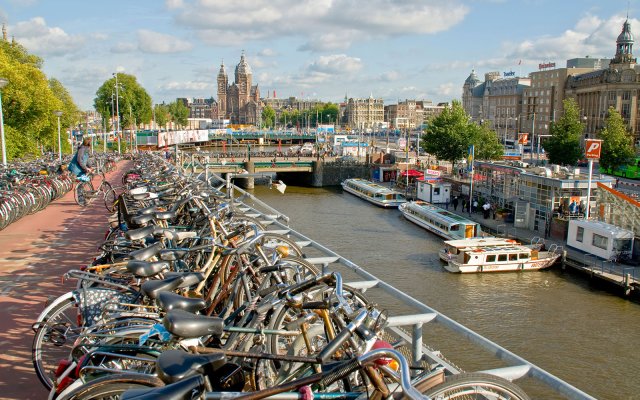
Dennis Cox—Alamy In central Amsterdam, bikes—as opposed to cars—are the norm, and 60 percent of people use the mode of two-wheel transportation. On the down side: bicyclists tend to whiz past you during a leisurely ride. Witness Dutch icons like windmills, fields of tulips, and storied castles by straying outward to North Amsterdam. With your rental bike in tow, hop a free ferry behind the central Amsterdam station and, once in North Amsterdam, travel through farm villages like Broek-in-Waterland and Uidam (11 miles total) before heading back to your hotel.
-
Minneapolis, Minnesota, U.S.A.
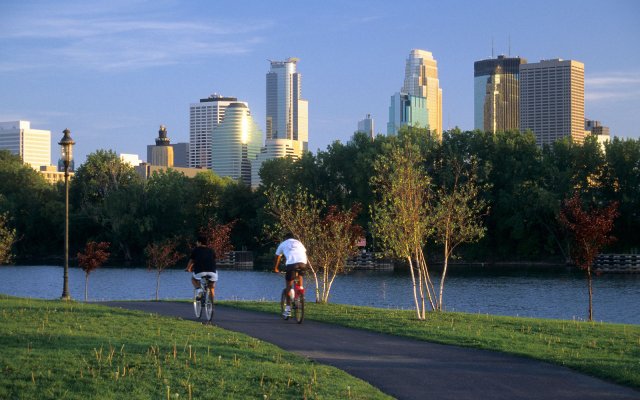
Greg Ryan—Alamy The Midwestern city counts five percent of its population (that’s 20,000 people, and the second-highest percentage in the U.S.) as two-wheel commuters—yes, even through the often bitter-cold winter. Local roaster Peace Coffee even delivers its beans by bike. Visitors can tool around the city on shared bikes through Nice Ride MN, or try out some 118 miles of on-street bikeways and 92 miles of off-street bikeways. Try the 5.7-mile Midtown Greenway, which takes you over the Martin Olav Sabo Bridge and grants access to the Chain of Lakes.
-
Portland, Oregon, U.S.A.
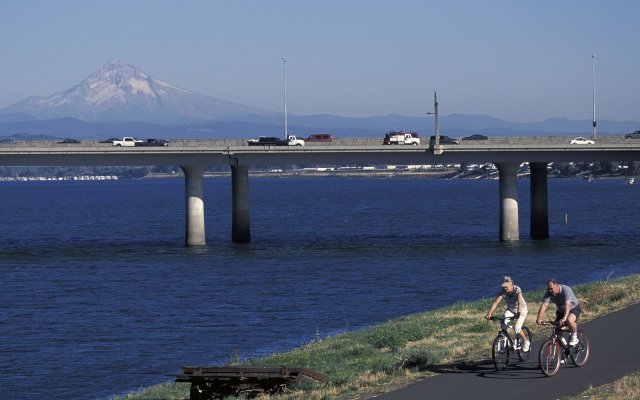
Danita Delimont—Alamy This Pacific Northwest city is crammed with cyclists—so much so that the city developed nine urban routes. The “Short, Steep, & Sweet,” a 15-mile hilly climb, winds through Portland’s West Hills neighborhood and affords views of Tualatin Valley before coasting downhill to Washington Park. Promoting paths like this is all part of the Portland Bicycle Plan for 2030, which hopes that 25 percent of all residents’ trips will be done on bike.
-
Copenhagen, Denmark
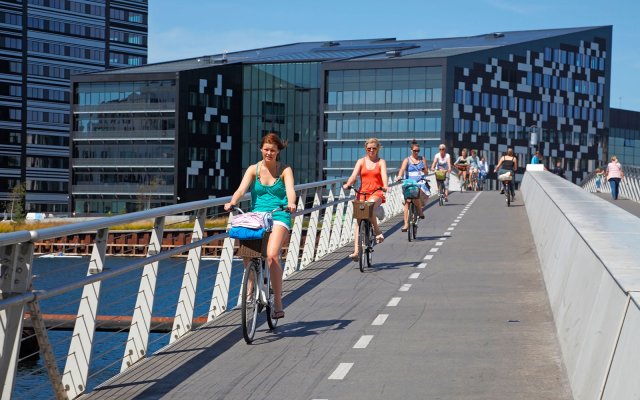
Niels Quist—Alamy Copenhagen is arguably the best biking city in the world, as evidenced by its 242 miles of designated bike lanes and the new Cycle Super Highway—a 13.7-mile stretch connecting Copenhagen with the suburb of Albertslund ,and the first of 26 “highways” just for bicyclists. There’s also the Instagram-worthy, year-old Cykelslangen, an elevated two-way bike lane painted bright orange, which connects the highway and harbor bridge.
-
Montreal, Quebec, Canada
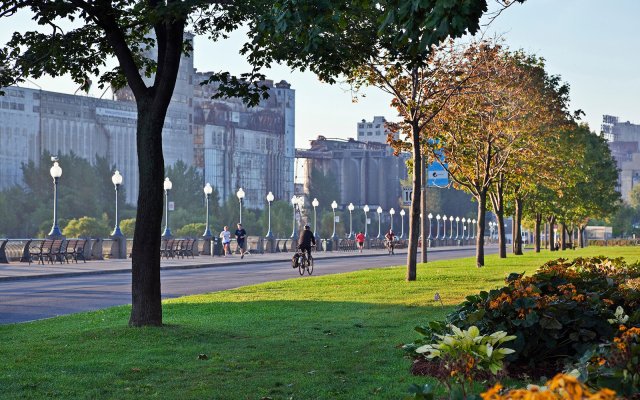
All Canada Photos/Alamy Canada’s most French metropolis is naturally going to be en amour with bicycles. Rent a two-wheeler through Bixi and opt for a ride along the Lachine Canal, where a bike path debuted during the 1970s. To reach the canal, depart from downtown on either Guy or Peel Streets. Bonus: along the 18.6-mile trip, you’ll have the chance to pop into Old Montreal and Old Port, adding just six miles to the journey.
-
Bordeaux, France
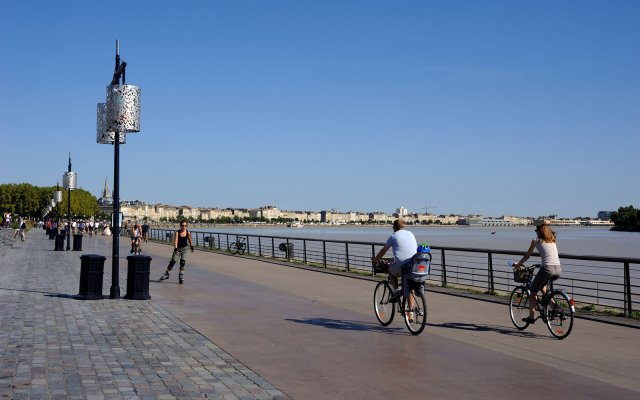
Vito Arcomano—Alamy In this bustling, pedestrian-friendly region, about 124 miles of bike paths satisfy a city of only 236,000. For a quick five-mile route that straddles both left and right banks, depart from Place Gambetta for views of world-class monuments (Grand Théâtre, Place de la Bourse, Porte Cailhau and Place du Palais) from your bicycle seat along Cours de l’Intendance, Cours du Chapeau Rouge, and Pont de Pierre.
-
Beijing, China
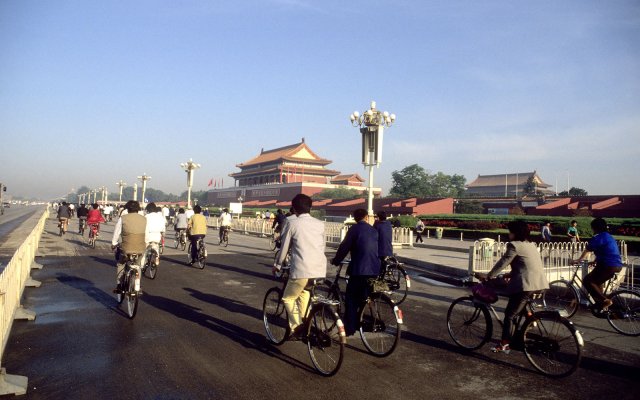
maurice joseph—Alamy While the chief reason for bicycling in this city—home to 20.2 million people—might be automobile congestion, it’s nonetheless a valid one. To avoid Beijing’s auto-traffic crunch, cruise along the Tongzhou canal, a 10-mile flat route that’s mostly vehicle-free and kicks off from the Grand Canal’s east bank (where Yunhe Xi Dajie turns into Tonghu Nan Lu). From this route it’s easy to enter the Grand Canal Ecological Route. Expect to see wetlands, bridges, river islands, and garden sculptures. There are also many spots along the way to stop for a picnic, so long as you’ve packed your own food.
-
Bogotá, Colombia
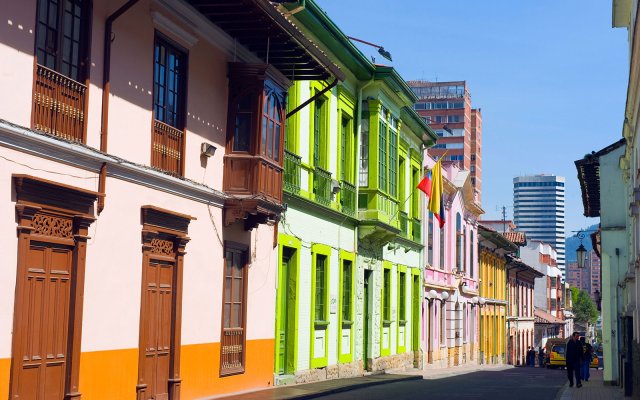
Robert Harding World Imagery/Alamy Outfitted with a 211-mile network of bicycle paths, Colombia’s largest city is in the middle of a commuting renaissance. Plan your trip over a Sunday to experience car-free roads between 7 a.m. and 2 p.m., a tradition that’s been going strong since the 1970s. Among today’s most popular cycling routes in Bogotá are those on the Complementary Network, which showcases the city’s green spaces and traveling along riverbanks.
Read the full list here. This article originally appeared on Travel + Leisure
More from Travel + Leisure:
-
Madison, Wisconsin, U.S.A.